
RAVE
Official implementation of the RAVE model: a Realtime Audio Variational autoEncoder
Stars: 1192
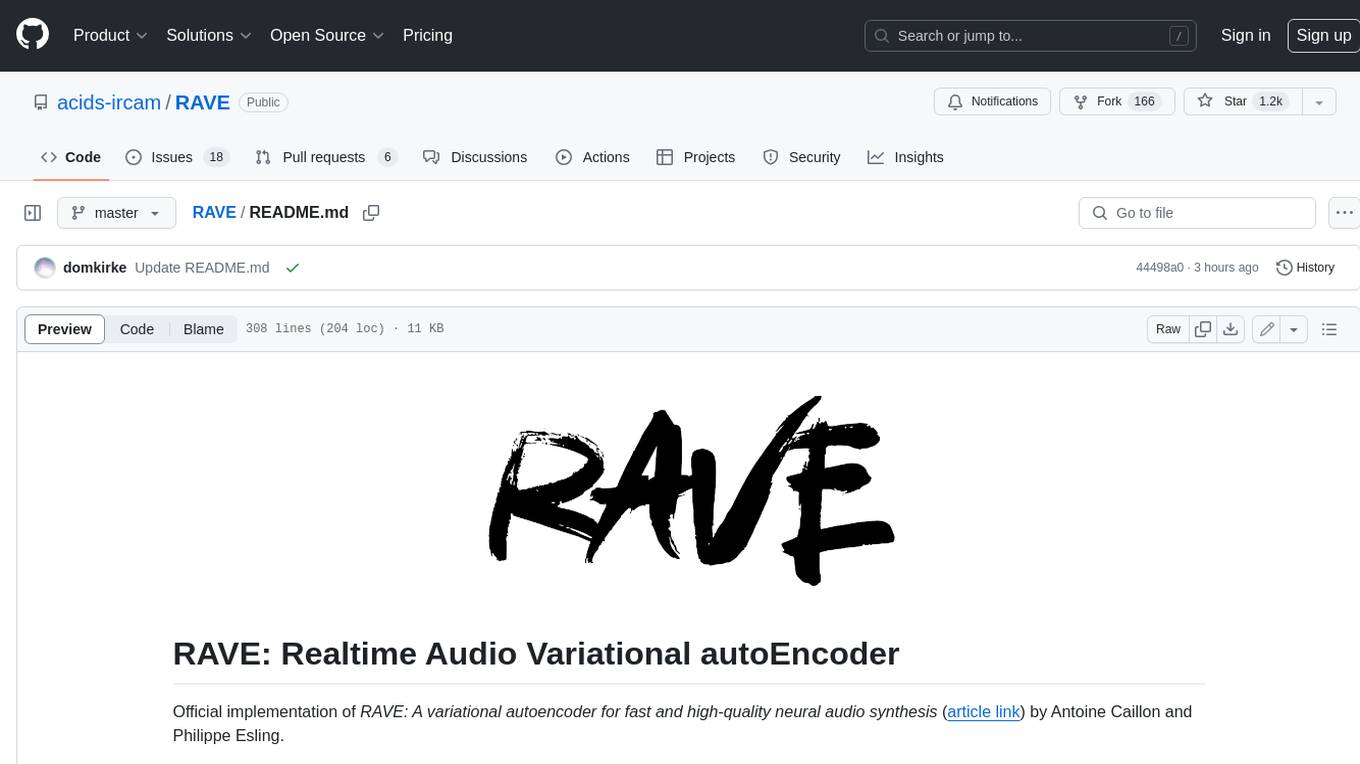
RAVE is a variational autoencoder for fast and high-quality neural audio synthesis. It can be used to generate new audio samples from a given dataset, or to modify the style of existing audio samples. RAVE is easy to use and can be trained on a variety of audio datasets. It is also computationally efficient, making it suitable for real-time applications.
README:
Official implementation of RAVE: A variational autoencoder for fast and high-quality neural audio synthesis (article link) by Antoine Caillon and Philippe Esling.
If you use RAVE as a part of a music performance or installation, be sure to cite either this repository or the article !
If you want to share / discuss / ask things about RAVE you can do so in our discord server !
Please check the FAQ before posting an issue!
RAVE VST RAVE VST for Windows, Mac and Linux is available as beta on the corresponding Forum IRCAM webpage. For problems, please write an issue here or on the Forum IRCAM discussion page.
Tutorials : new tutorials are available on the Forum IRCAM webpage, and video versions are coming soon!
- Tutorial: Neural Synthesis in a DAW with RAVE
- Tutorial: Neural Synthesis in Max 8 with RAVE
- Tutorial: Training RAVE models on custom data
The original implementation of the RAVE model can be restored using
git checkout v1Install RAVE using
pip install acids-raveWarning It is strongly advised to install torch and torchaudio before acids-rave, so you can choose the appropriate version of torch on the library website. For future compatibility with new devices (and modern Python environments), rave-acids does not enforce torch==1.13 anymore.
You will need ffmpeg on your computer. You can install it locally inside your virtual environment using
conda install ffmpegA colab to train RAVEv2 is now available thanks to hexorcismos !
Training a RAVE model usually involves 3 separate steps, namely dataset preparation, training and export.
You can know prepare a dataset using two methods: regular and lazy. Lazy preprocessing allows RAVE to be trained directly on the raw files (i.e. mp3, ogg), without converting them first. Warning: lazy dataset loading will increase your CPU load by a large margin during training, especially on Windows. This can however be useful when training on large audio corpus which would not fit on a hard drive when uncompressed. In any case, prepare your dataset using
rave preprocess --input_path /audio/folder --output_path /dataset/path --channels X (--lazy)RAVEv2 has many different configurations. The improved version of the v1 is called v2, and can therefore be trained with
rave train --config v2 --db_path /dataset/path --out_path /model/out --name give_a_name --channels XWe also provide a discrete configuration, similar to SoundStream or EnCodec
rave train --config discrete ...By default, RAVE is built with non-causal convolutions. If you want to make the model causal (hence lowering the overall latency of the model), you can use the causal mode
rave train --config discrete --config causal ...New in 2.3, data augmentations are also available to improve the model's generalization in low data regimes. You can add data augmentation by adding augmentation configuration files with the --augment keyword
rave train --config v2 --augment mute --augment compressMany other configuration files are available in rave/configs and can be combined. Here is a list of all the available configurations & augmentations :
| Type | Name | Description |
|---|---|---|
| Architecture | v1 | Original continuous model (minimum GPU memory : 8Go) |
| v2 | Improved continuous model (faster, higher quality) (minimum GPU memory : 16Go) | |
| v2_small | v2 with a smaller receptive field, adpated adversarial training, and noise generator, adapted for timbre transfer for stationary signals (minimum GPU memory : 8Go) | |
| v2_nopqmf | (experimental) v2 without pqmf in generator (more efficient for bending purposes) (minimum GPU memory : 16Go) | |
| v3 | v2 with Snake activation, descript discriminator and Adaptive Instance Normalization for real style transfer (minimum GPU memory : 32Go) | |
| discrete | Discrete model (similar to SoundStream or EnCodec) (minimum GPU memory : 18Go) | |
| onnx | Noiseless v1 configuration for onnx usage (minimum GPU memory : 6Go) | |
| raspberry | Lightweight configuration compatible with realtime RaspberryPi 4 inference (minimum GPU memory : 5Go) | |
| Regularization (v2 only) | default | Variational Auto Encoder objective (ELBO) |
| wasserstein | Wasserstein Auto Encoder objective (MMD) | |
| spherical | Spherical Auto Encoder objective | |
| Discriminator | spectral_discriminator | Use the MultiScale discriminator from EnCodec. |
| Others | causal | Use causal convolutions |
| noise | Enables noise synthesizer V2 | |
| hybrid | Enable mel-spectrogram input | |
| Augmentations | mute | Randomly mutes data batches (default prob : 0.1). Enforces the model to learn silence |
| compress | Randomly compresses the waveform (equivalent to light non-linear amplification of batches) | |
| gain | Applies a random gain to waveform (default range : [-6, 3]) |
Once trained, export your model to a torchscript file using
rave export --run /path/to/your/run (--streaming)Setting the --streaming flag will enable cached convolutions, making the model compatible with realtime processing. If you forget to use the streaming mode and try to load the model in Max, you will hear clicking artifacts.
For discrete models, we redirect the user to the msprior library here. However, as this library is still experimental, the prior from version 1.x has been re-integrated in v2.3.
To train a prior for a pretrained RAVE model :
rave train_prior --model /path/to/your/run --db_path /path/to/your_preprocessed_data --out_path /path/to/outputthis will train a prior over the latent of the pretrained model path/to/your/run, and save the model and tensorboard logs to folder /path/to/output.
To script a prior along with a RAVE model, export your model by providing the --prior keyword to your pretrained prior :
rave export --run /path/to/your/run --prior /path/to/your/prior (--streaming)Several pretrained streaming models are available here. We'll keep the list updated with new models.
This section presents how RAVE can be loaded inside nn~ in order to be used live with Max/MSP or PureData.
A pretrained RAVE model named darbouka.gin available on your computer can be loaded inside nn~ using the following syntax, where the default method is set to forward (i.e. encode then decode)
This does the same thing as the following patch, but slightly faster.
Having an explicit access to the latent representation yielded by RAVE allows us to interact with the representation using Max/MSP or PureData signal processing tools:
By default, RAVE can be used as a style transfer tool, based on the large compression ratio of the model. We recently added a technique inspired from StyleGAN to include Adaptive Instance Normalization to the reconstruction process, effectively allowing to define source and target styles directly inside Max/MSP or PureData, using the attribute system of nn~.
Other attributes, such as enable or gpu can enable/disable computation, or use the gpu to speed up things (still experimental).
A batch generation script has been released in v2.3 to allow transformation of large amount of files
rave generate model_path path_1 path_2 --out out_pathwhere model_path is the path to your trained model (original or scripted), path_X a list of audio files or directories, and out_path the out directory of the generations.
If you have questions, want to share your experience with RAVE or share musical pieces done with the model, you can use the Discussion tab !
Demonstration of what you can do with RAVE and the nn~ external for maxmsp !
Using nn~ for puredata, RAVE can be used in realtime on embedded platforms !
Question : my preprocessing is stuck, showing 0it[00:00, ?it/s]
Answer : This means that the audio files in your dataset are too short to provide a sufficient temporal scope to RAVE. Try decreasing the signal window with the --num_signal XXX(samples) with preprocess, without forgetting afterwards to add the --n_signal XXX(samples) with train
Question : During training I got an exception resembling ValueError: n_components=128 must be between 0 and min(n_samples, n_features)=64 with svd_solver='full'
Answer : This means that your dataset does not have enough data batches to compute the intern latent PCA, that requires at least 128 examples (then batches).
This work is led at IRCAM, and has been funded by the following projects
- ANR MakiMono
- ACTOR
- DAFNE+ N° 101061548
For Tasks:
Click tags to check more tools for each tasksFor Jobs:
Alternative AI tools for RAVE
Similar Open Source Tools

RAVE
RAVE is a variational autoencoder for fast and high-quality neural audio synthesis. It can be used to generate new audio samples from a given dataset, or to modify the style of existing audio samples. RAVE is easy to use and can be trained on a variety of audio datasets. It is also computationally efficient, making it suitable for real-time applications.
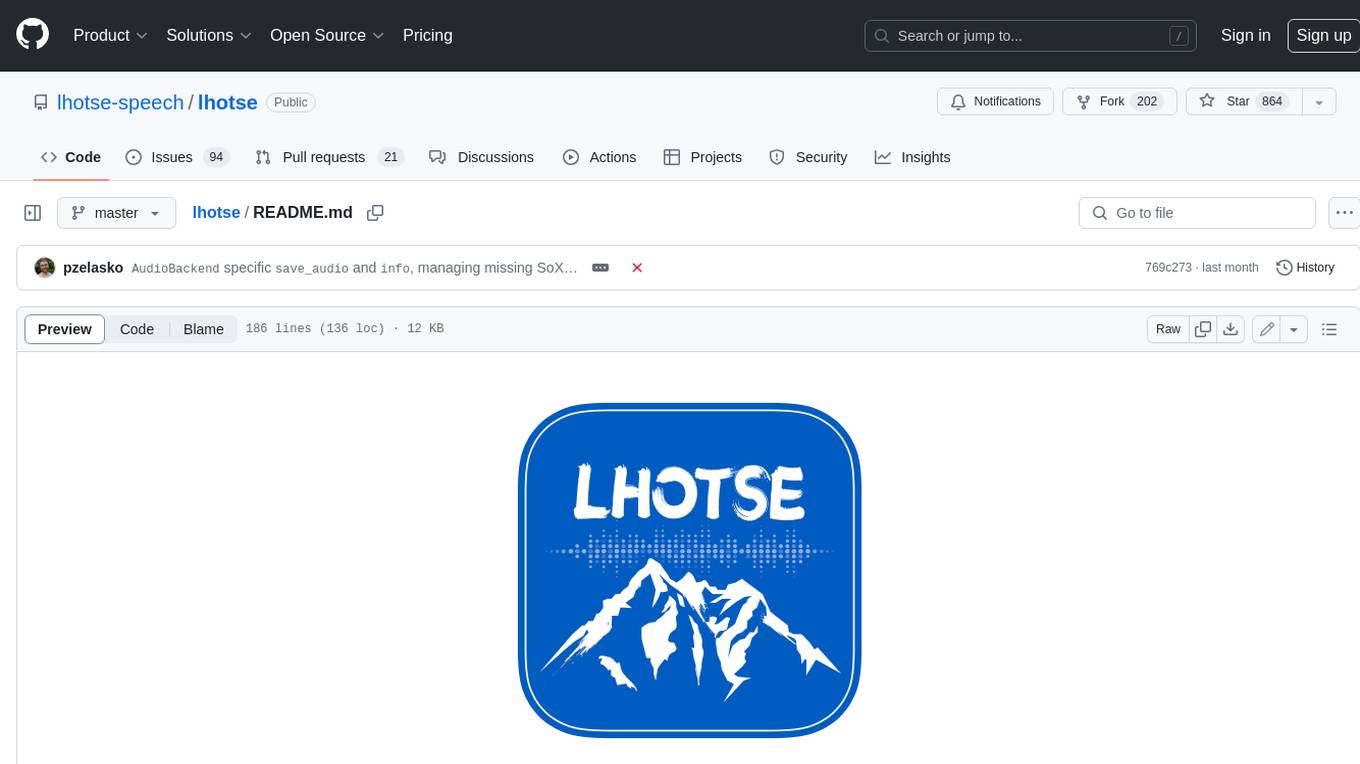
lhotse
Lhotse is a Python library designed to make speech and audio data preparation flexible and accessible. It aims to attract a wider community to speech processing tasks by providing a Python-centric design and an expressive command-line interface. Lhotse offers standard data preparation recipes, PyTorch Dataset classes for speech tasks, and efficient data preparation for model training with audio cuts. It supports data augmentation, feature extraction, and feature-space cut mixing. The tool extends Kaldi's data preparation recipes with seamless PyTorch integration, human-readable text manifests, and convenient Python classes.
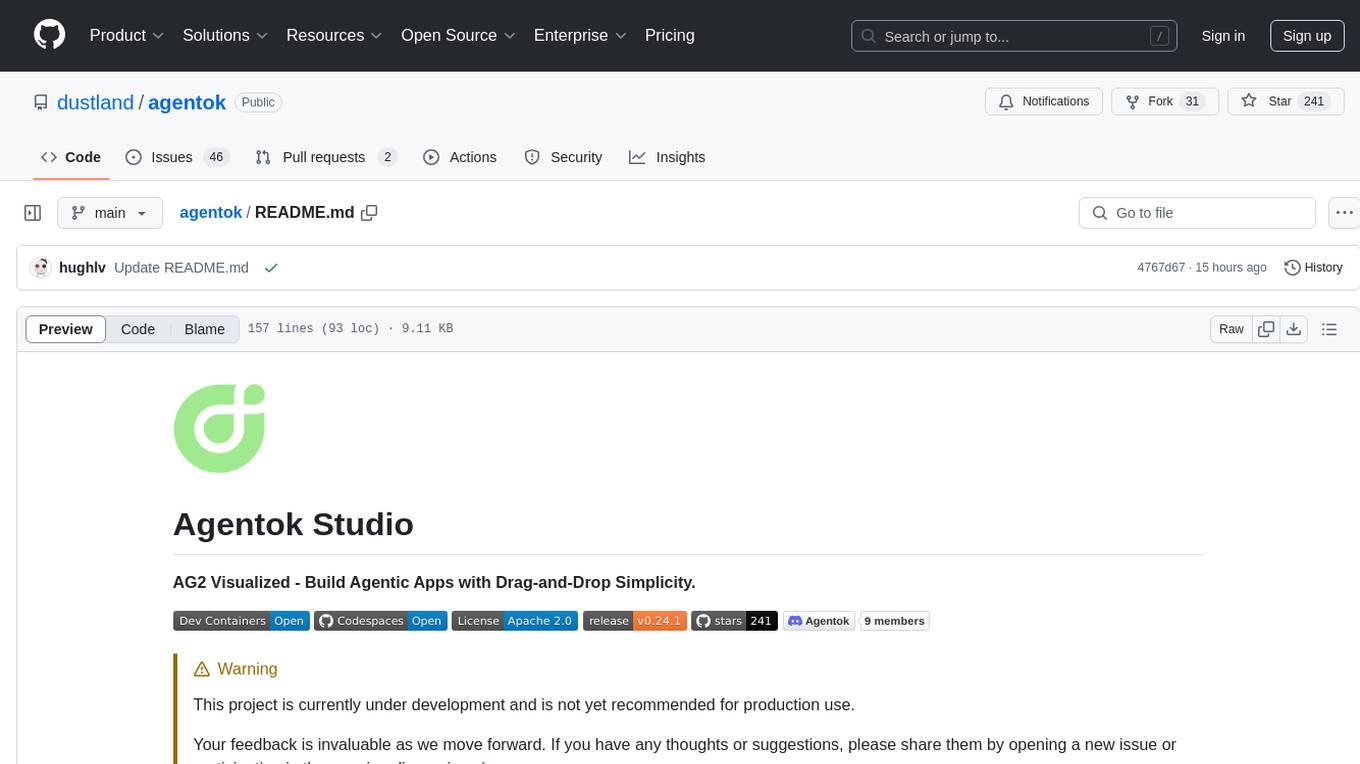
agentok
Agentok Studio is a tool built upon AG2, a powerful agent framework from Microsoft, offering intuitive visual tools to streamline the creation and management of complex agent-based workflows. It simplifies the process for creators and developers by generating native Python code with minimal dependencies, enabling users to create self-contained code that can be executed anywhere. The tool is currently under development and not recommended for production use, but contributions are welcome from the community to enhance its capabilities and functionalities.
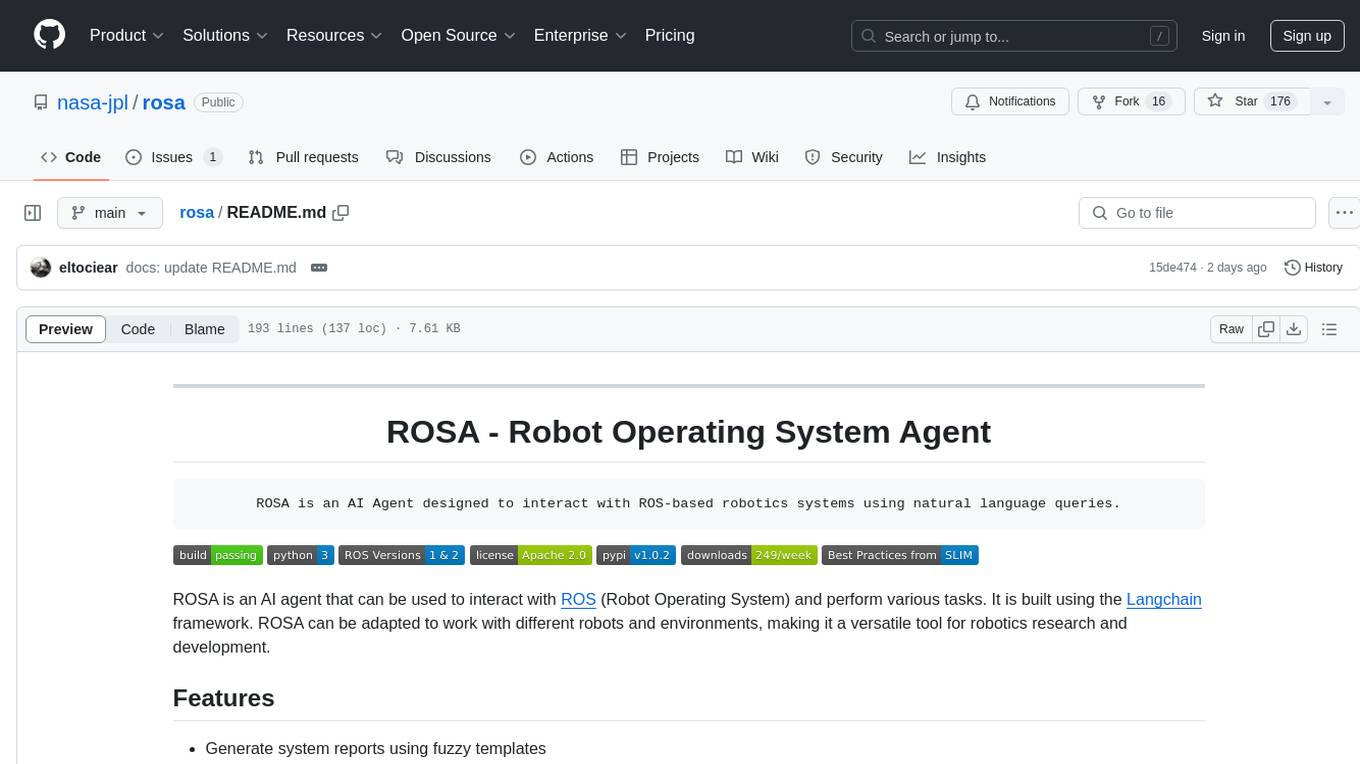
rosa
ROSA is an AI Agent designed to interact with ROS-based robotics systems using natural language queries. It can generate system reports, read and parse ROS log files, adapt to new robots, and run various ROS commands using natural language. The tool is versatile for robotics research and development, providing an easy way to interact with robots and the ROS environment.
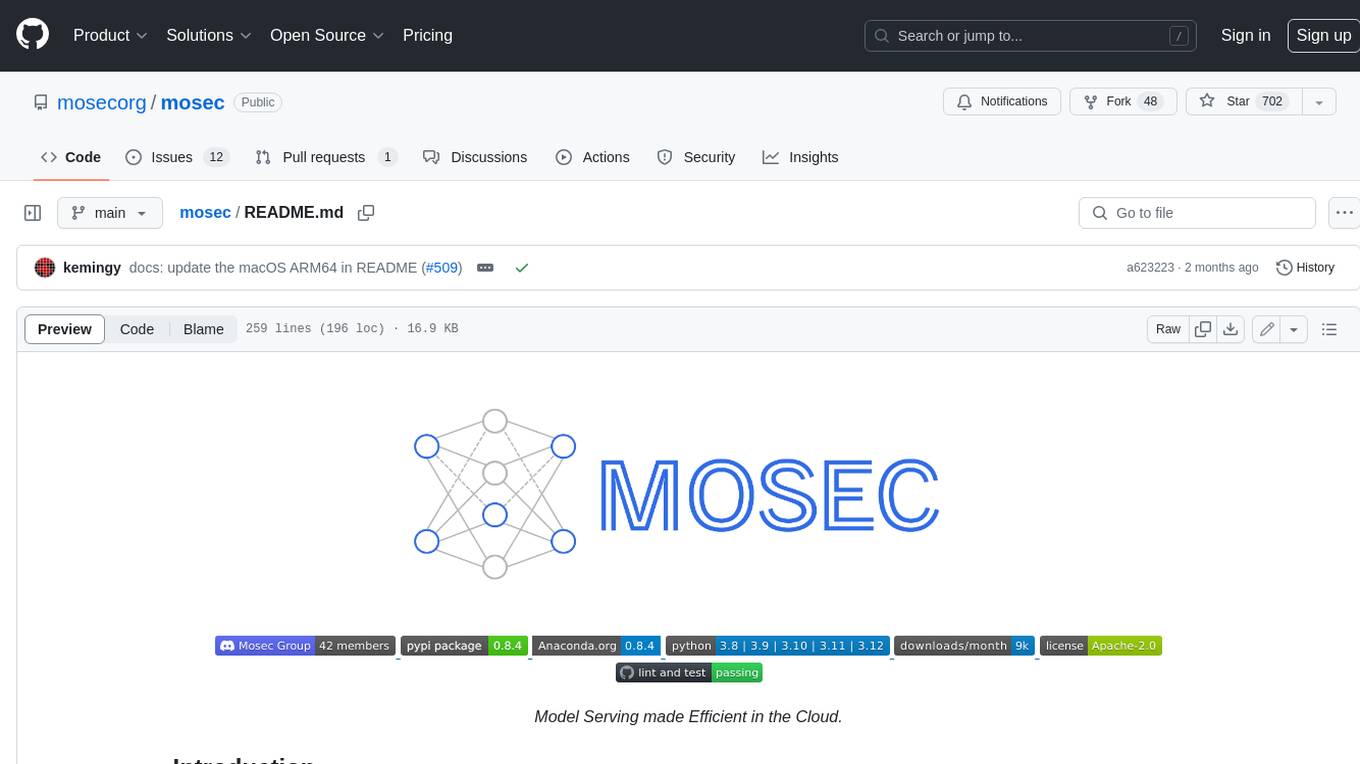
mosec
Mosec is a high-performance and flexible model serving framework for building ML model-enabled backend and microservices. It bridges the gap between any machine learning models you just trained and the efficient online service API. * **Highly performant** : web layer and task coordination built with Rust 🦀, which offers blazing speed in addition to efficient CPU utilization powered by async I/O * **Ease of use** : user interface purely in Python 🐍, by which users can serve their models in an ML framework-agnostic manner using the same code as they do for offline testing * **Dynamic batching** : aggregate requests from different users for batched inference and distribute results back * **Pipelined stages** : spawn multiple processes for pipelined stages to handle CPU/GPU/IO mixed workloads * **Cloud friendly** : designed to run in the cloud, with the model warmup, graceful shutdown, and Prometheus monitoring metrics, easily managed by Kubernetes or any container orchestration systems * **Do one thing well** : focus on the online serving part, users can pay attention to the model optimization and business logic
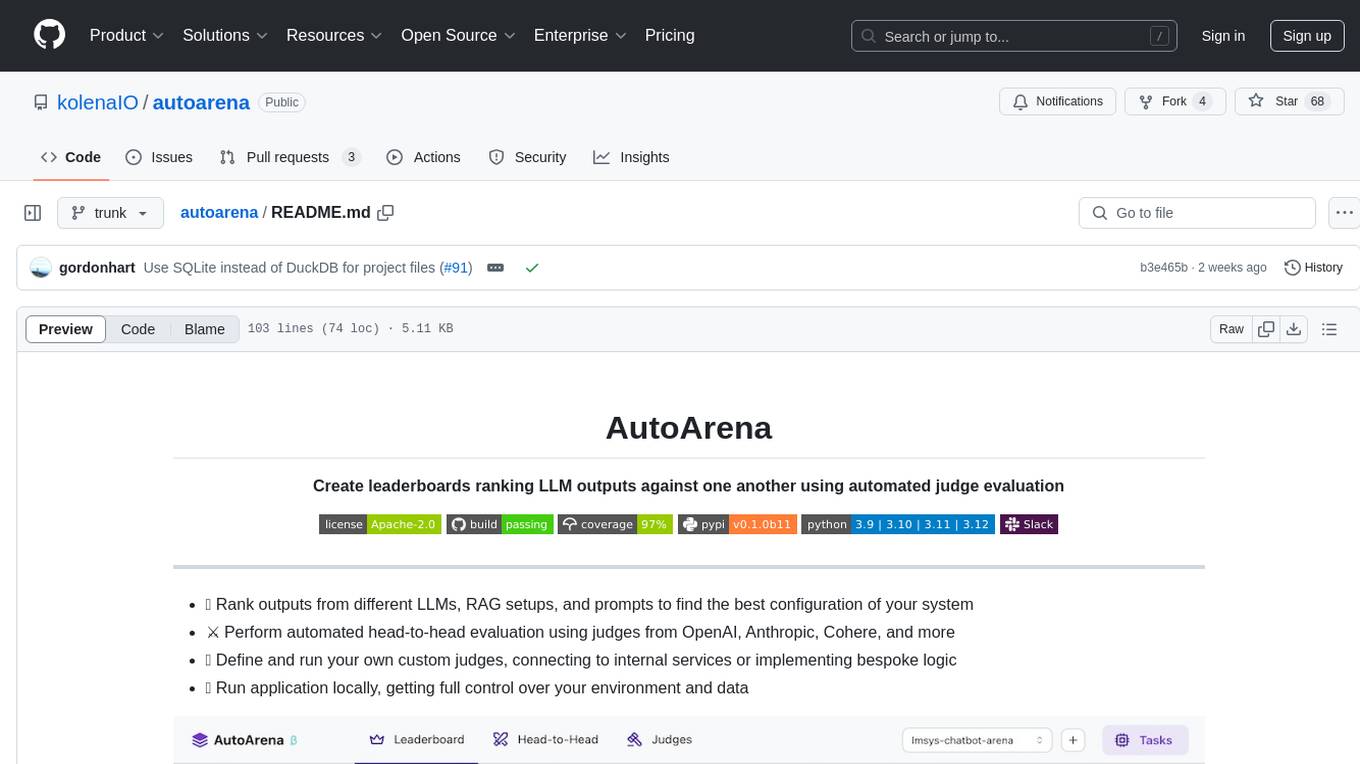
autoarena
AutoArena is a tool designed to create leaderboards ranking Language Model outputs against one another using automated judge evaluation. It allows users to rank outputs from different LLMs, RAG setups, and prompts to find the best configuration of their system. Users can perform automated head-to-head evaluation using judges from various platforms like OpenAI, Anthropic, and Cohere. Additionally, users can define and run custom judges, connect to internal services, or implement bespoke logic. AutoArena enables users to run the application locally, providing full control over their environment and data.
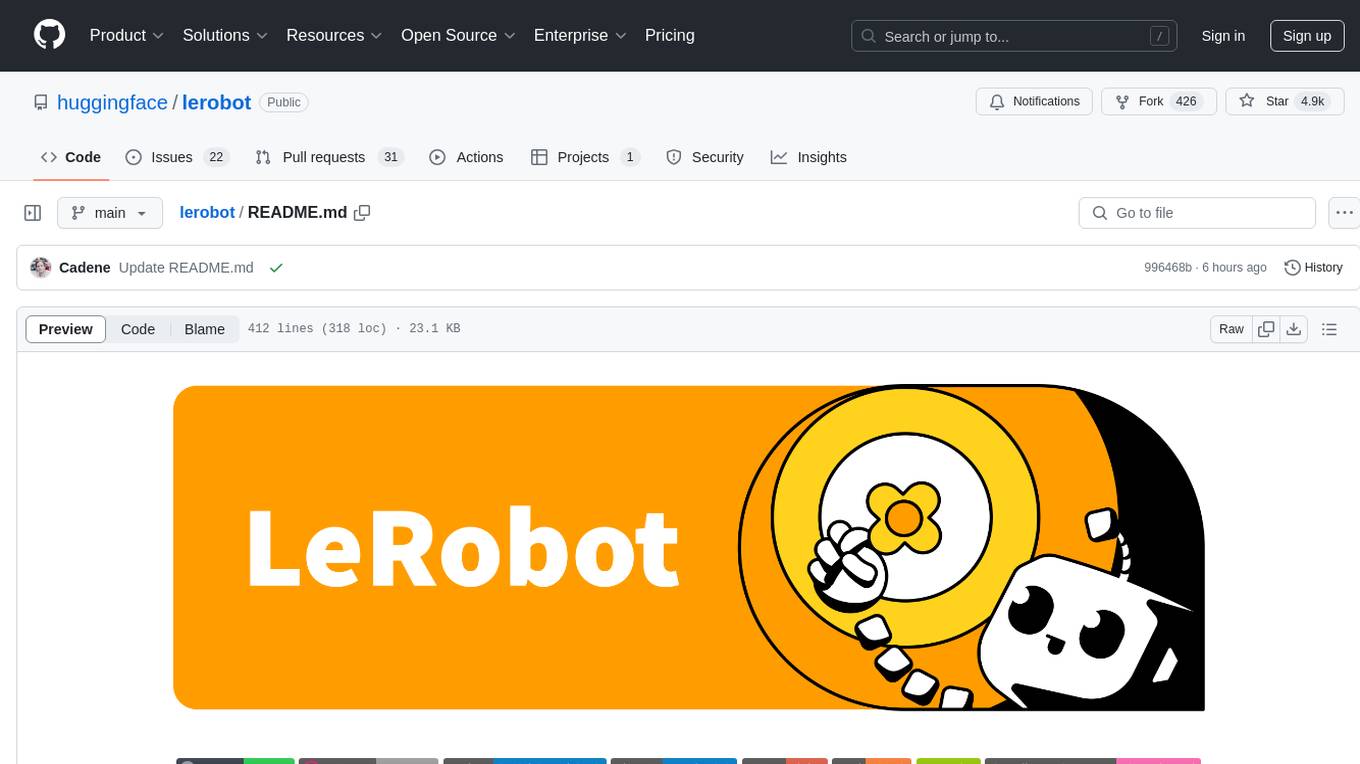
lerobot
LeRobot is a state-of-the-art AI library for real-world robotics in PyTorch. It aims to provide models, datasets, and tools to lower the barrier to entry to robotics, focusing on imitation learning and reinforcement learning. LeRobot offers pretrained models, datasets with human-collected demonstrations, and simulation environments. It plans to support real-world robotics on affordable and capable robots. The library hosts pretrained models and datasets on the Hugging Face community page.

magika
Magika is a novel AI-powered file type detection tool that relies on deep learning to provide accurate detection. It employs a custom, highly optimized model to enable precise file identification within milliseconds. Trained on a dataset of ~100M samples across 200+ content types, achieving an average ~99% accuracy. Used at scale by Google to improve user safety by routing files to security scanners. Available as a command line tool in Rust, Python API, and bindings for Rust, JavaScript/TypeScript, and GoLang.
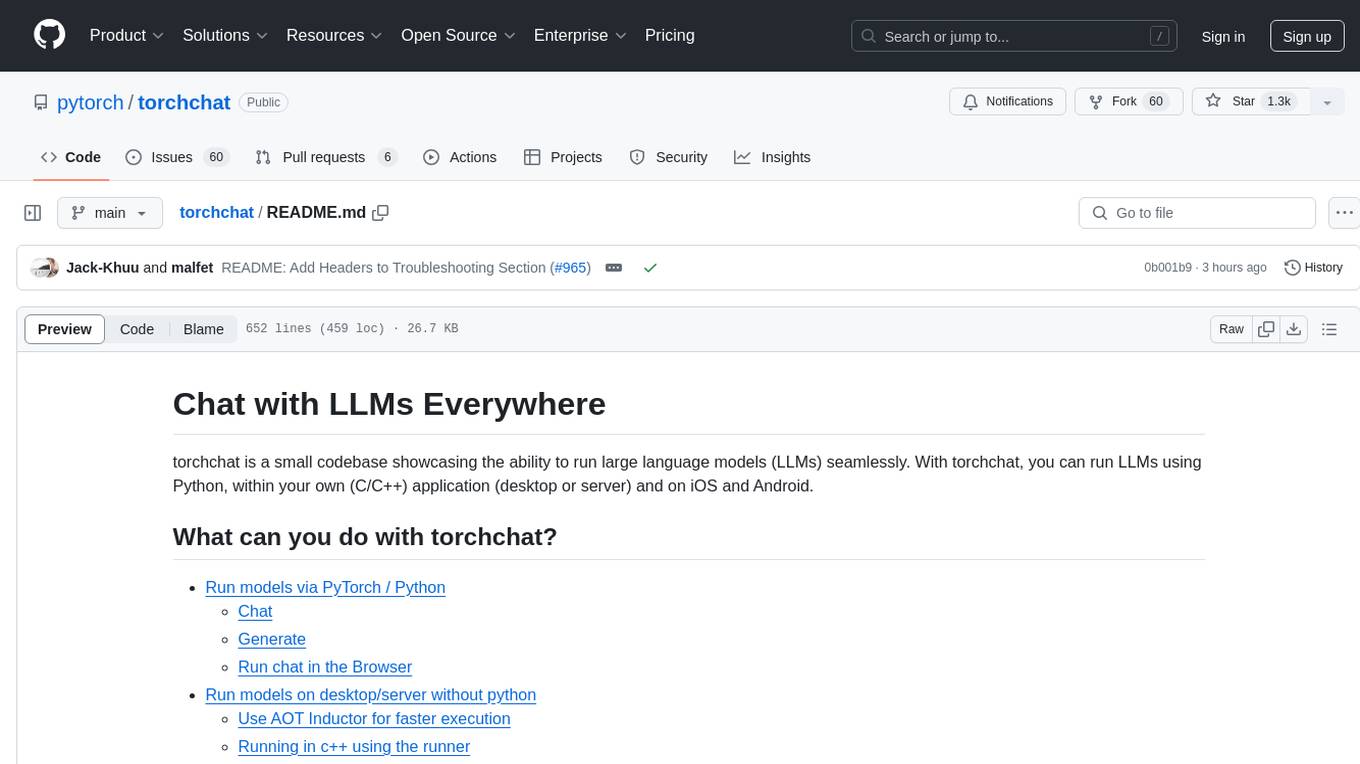
torchchat
torchchat is a codebase showcasing the ability to run large language models (LLMs) seamlessly. It allows running LLMs using Python in various environments such as desktop, server, iOS, and Android. The tool supports running models via PyTorch, chatting, generating text, running chat in the browser, and running models on desktop/server without Python. It also provides features like AOT Inductor for faster execution, running in C++ using the runner, and deploying and running on iOS and Android. The tool supports popular hardware and OS including Linux, Mac OS, Android, and iOS, with various data types and execution modes available.
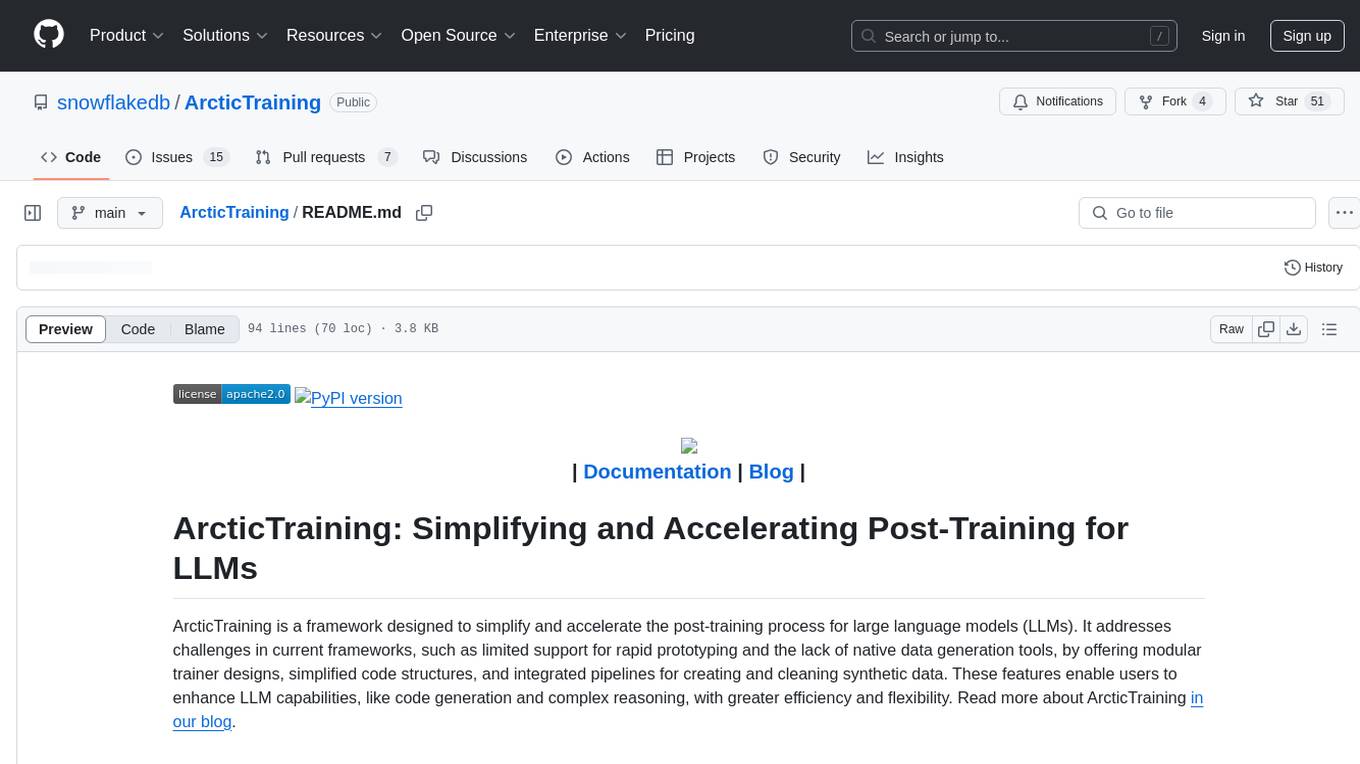
ArcticTraining
ArcticTraining is a framework designed to simplify and accelerate the post-training process for large language models (LLMs). It offers modular trainer designs, simplified code structures, and integrated pipelines for creating and cleaning synthetic data, enabling users to enhance LLM capabilities like code generation and complex reasoning with greater efficiency and flexibility.
obs-cleanstream
CleanStream is an OBS plugin that utilizes real-time local AI to clean live audio streams by removing unwanted words and utterances, such as 'uh' and 'um', and configurable words like profanity. It employs a neural network (OpenAI Whisper) to predict speech in real-time and eliminate undesired words. The plugin runs efficiently using the Whisper.cpp project from ggerganov. CleanStream offers users the ability to adjust settings and add the plugin to any audio-generating source in OBS, providing a seamless experience for content creators looking to enhance the quality of their live audio streams.

obs-cleanstream
CleanStream is an OBS plugin that utilizes AI to clean live audio streams by removing unwanted words and utterances, such as 'uh's and 'um's, and configurable words like profanity. It uses a neural network (OpenAI Whisper) in real-time to predict speech and eliminate unwanted words. The plugin is still experimental and not recommended for live production use, but it is functional for testing purposes. Users can adjust settings and configure the plugin to enhance audio quality during live streams.
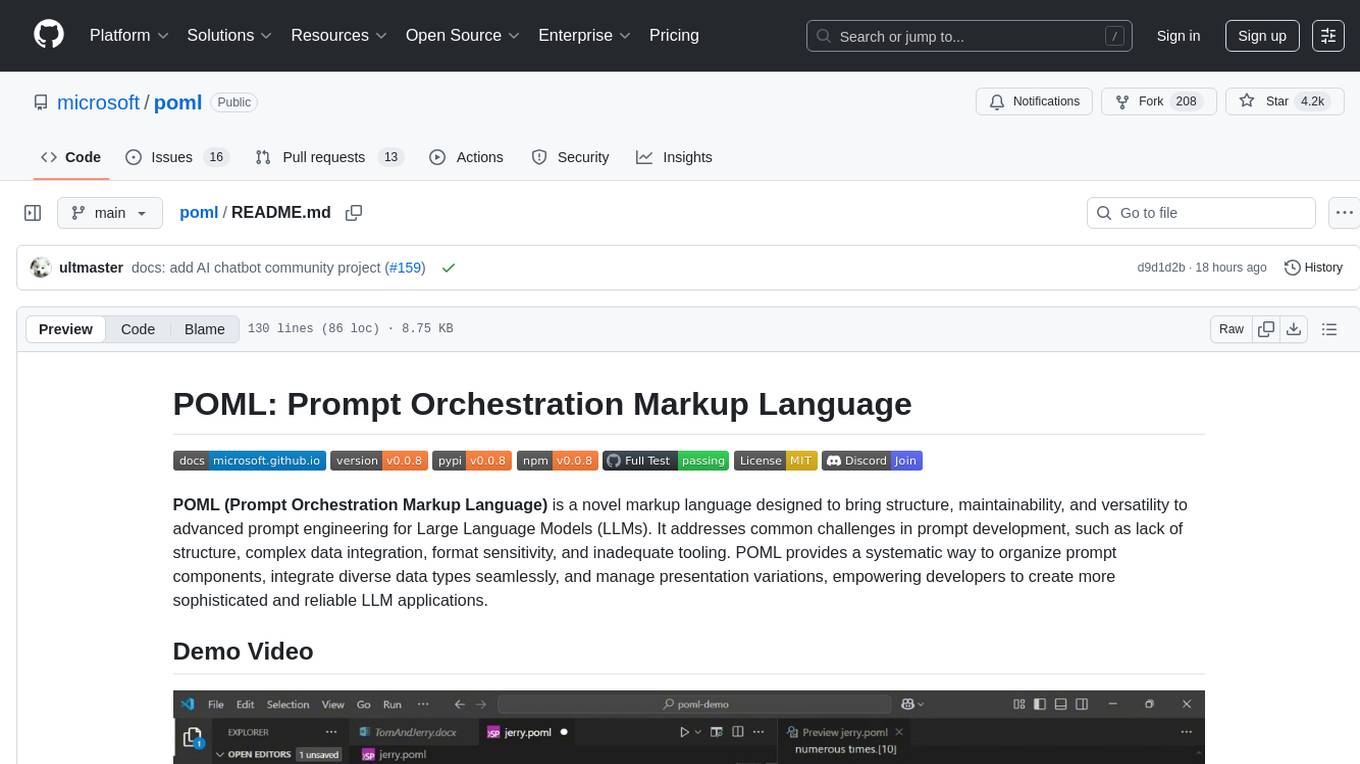
poml
POML (Prompt Orchestration Markup Language) is a novel markup language designed to bring structure, maintainability, and versatility to advanced prompt engineering for Large Language Models (LLMs). It addresses common challenges in prompt development, such as lack of structure, complex data integration, format sensitivity, and inadequate tooling. POML provides a systematic way to organize prompt components, integrate diverse data types seamlessly, and manage presentation variations, empowering developers to create more sophisticated and reliable LLM applications.
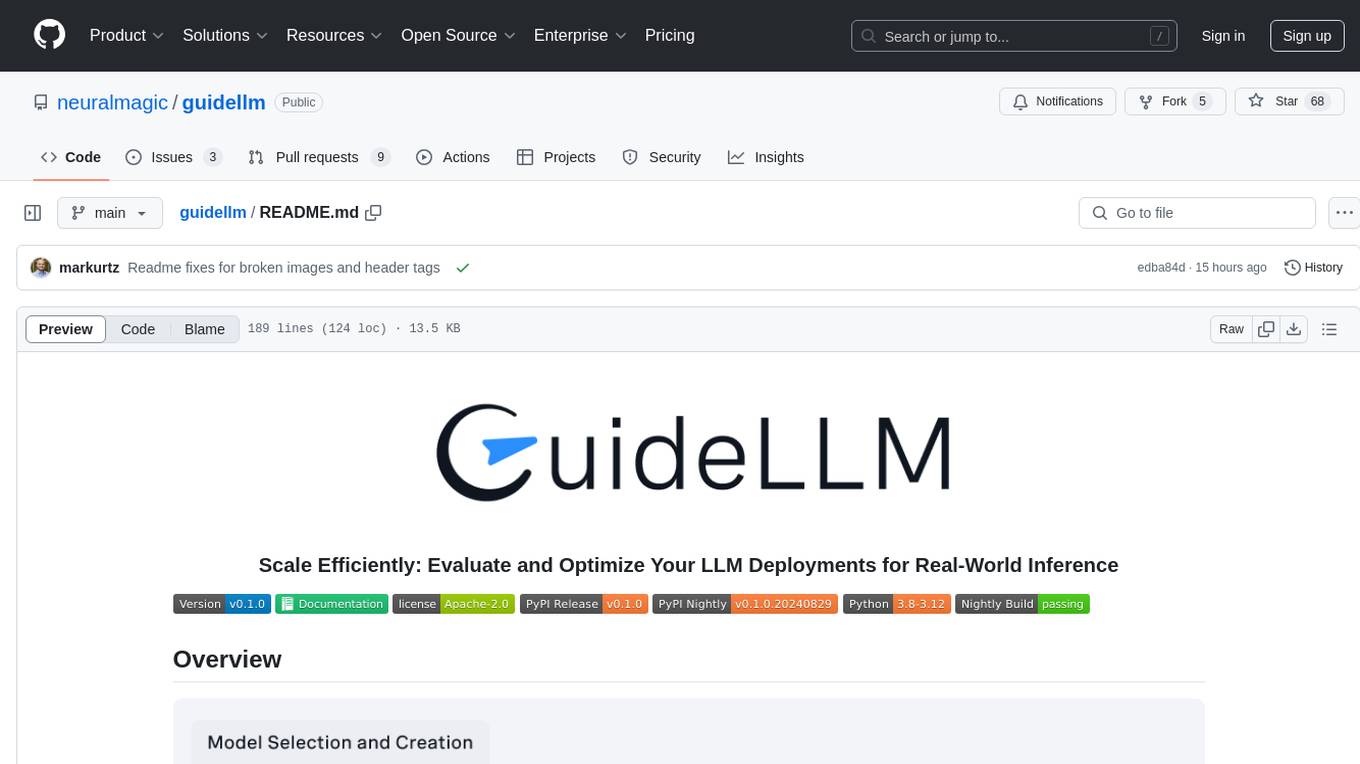
guidellm
GuideLLM is a powerful tool for evaluating and optimizing the deployment of large language models (LLMs). By simulating real-world inference workloads, GuideLLM helps users gauge the performance, resource needs, and cost implications of deploying LLMs on various hardware configurations. This approach ensures efficient, scalable, and cost-effective LLM inference serving while maintaining high service quality. Key features include performance evaluation, resource optimization, cost estimation, and scalability testing.
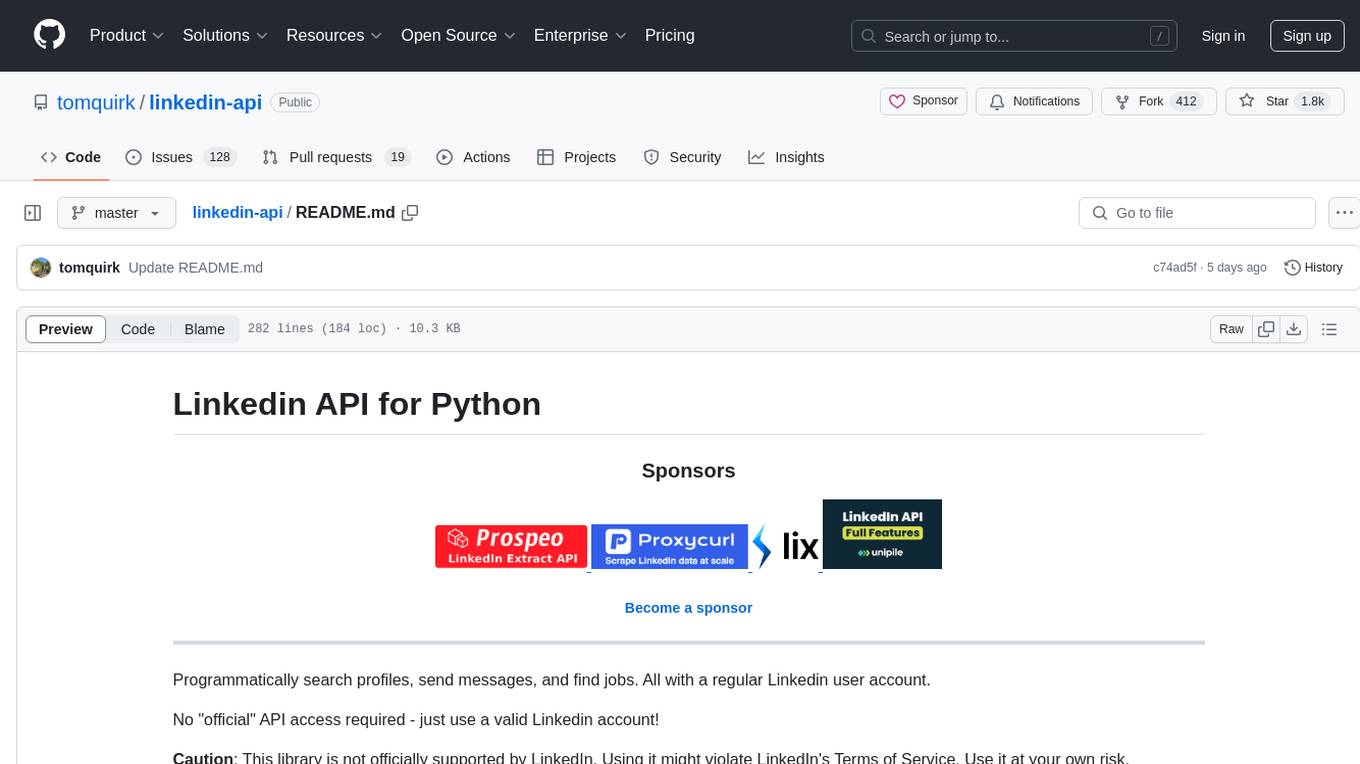
linkedin-api
The Linkedin API for Python allows users to programmatically search profiles, send messages, and find jobs using a regular Linkedin user account. It does not require 'official' API access, just a valid Linkedin account. However, it is important to note that this library is not officially supported by LinkedIn and using it may violate LinkedIn's Terms of Service. Users can authenticate using any Linkedin account credentials and access features like getting profiles, profile contact info, and connections. The library also provides commercial alternatives for extracting data, scraping public profiles, and accessing a full LinkedIn API. It is not endorsed or supported by LinkedIn and is intended for educational purposes and personal use only.

Easy-Translate
Easy-Translate is a script designed for translating large text files with a single command. It supports various models like M2M100, NLLB200, SeamlessM4T, LLaMA, and Bloom. The tool is beginner-friendly and offers seamless and customizable features for advanced users. It allows acceleration on CPU, multi-CPU, GPU, multi-GPU, and TPU, with support for different precisions and decoding strategies. Easy-Translate also provides an evaluation script for translations. Built on HuggingFace's Transformers and Accelerate library, it supports prompt usage and loading huge models efficiently.
For similar tasks

RAVE
RAVE is a variational autoencoder for fast and high-quality neural audio synthesis. It can be used to generate new audio samples from a given dataset, or to modify the style of existing audio samples. RAVE is easy to use and can be trained on a variety of audio datasets. It is also computationally efficient, making it suitable for real-time applications.
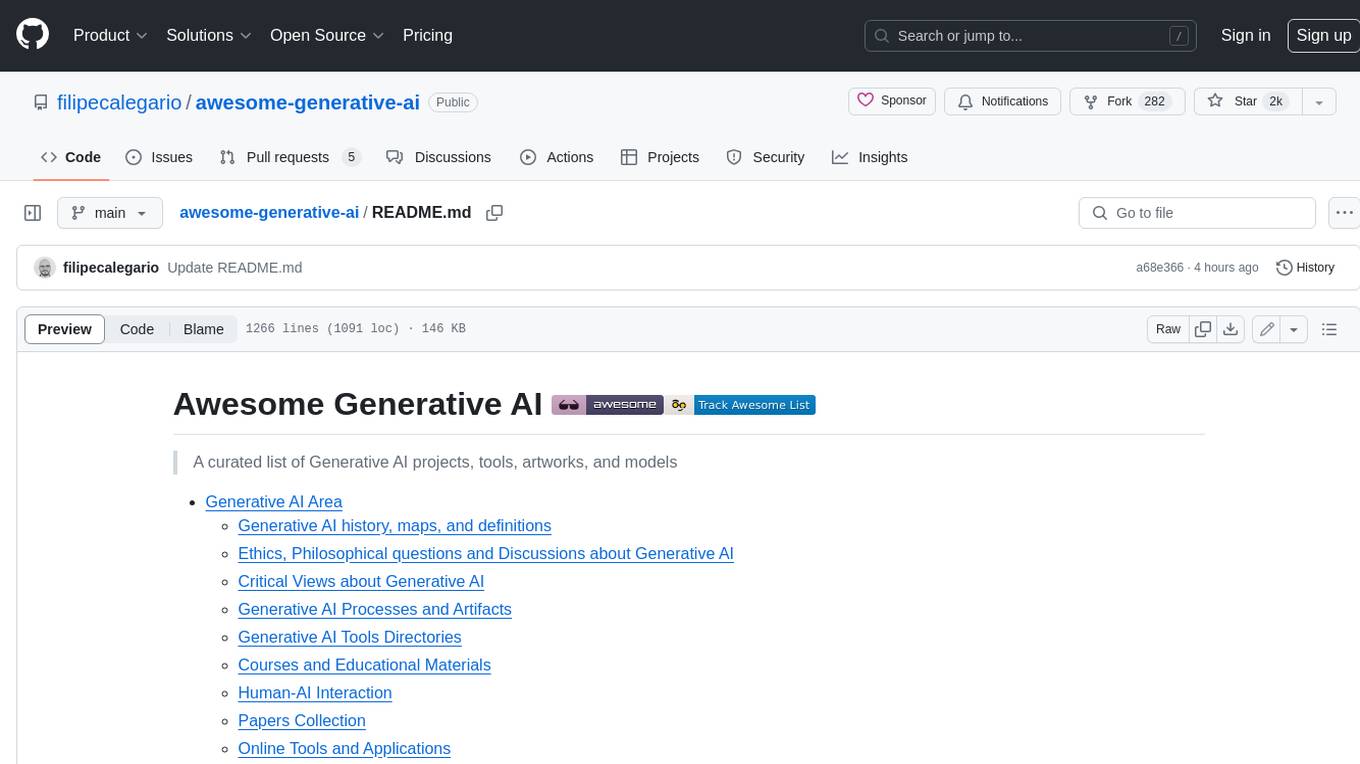
awesome-generative-ai
A curated list of Generative AI projects, tools, artworks, and models
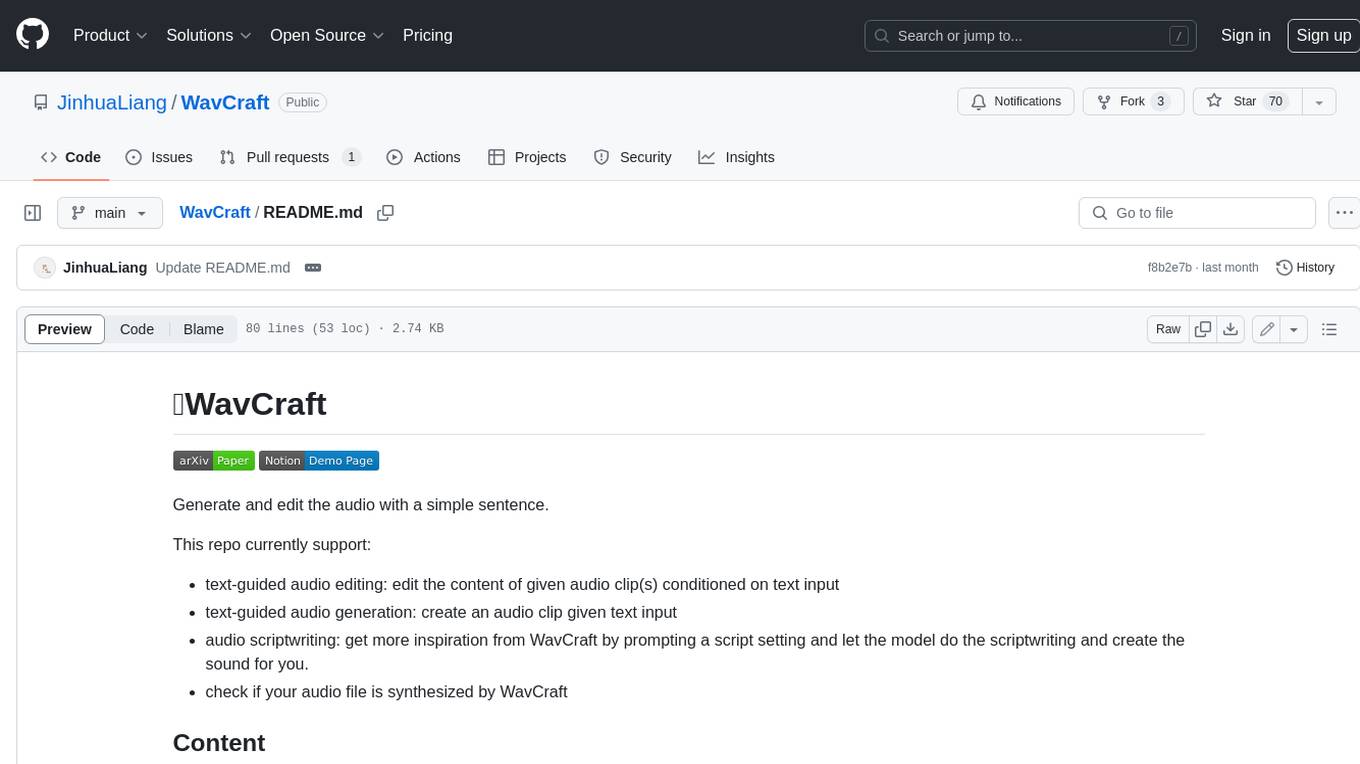
WavCraft
WavCraft is an LLM-driven agent for audio content creation and editing. It applies LLM to connect various audio expert models and DSP function together. With WavCraft, users can edit the content of given audio clip(s) conditioned on text input, create an audio clip given text input, get more inspiration from WavCraft by prompting a script setting and let the model do the scriptwriting and create the sound, and check if your audio file is synthesized by WavCraft.
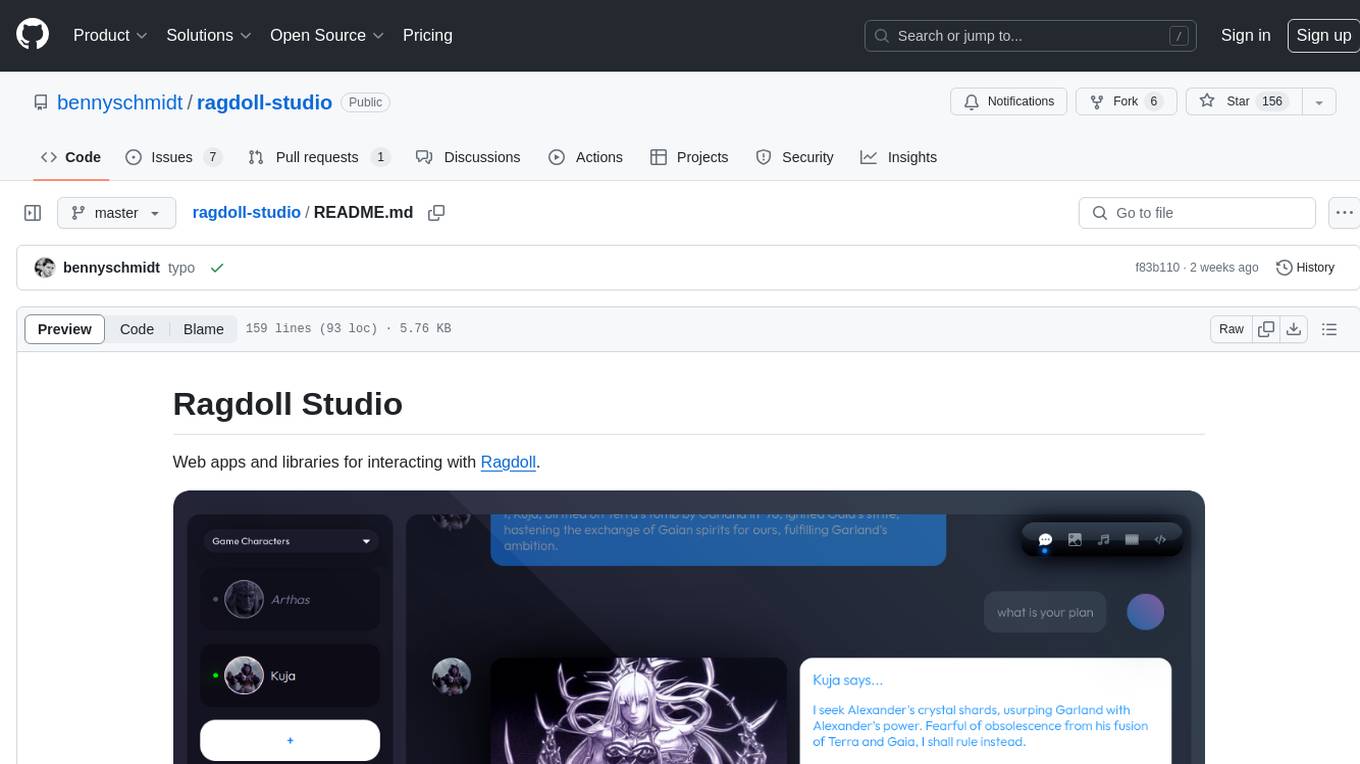
ragdoll-studio
Ragdoll Studio is a platform offering web apps and libraries for interacting with Ragdoll, enabling users to go beyond fine-tuning and create flawless creative deliverables, rich multimedia, and engaging experiences. It provides various modes such as Story Mode for creating and chatting with characters, Vector Mode for producing vector art, Raster Mode for producing raster art, Video Mode for producing videos, Audio Mode for producing audio, and 3D Mode for producing 3D objects. Users can export their content in various formats and share their creations on the community site. The platform consists of a Ragdoll API and a front-end React application for seamless usage.

ChatTTS-Forge
ChatTTS-Forge is a powerful text-to-speech generation tool that supports generating rich audio long texts using a SSML-like syntax and provides comprehensive API services, suitable for various scenarios. It offers features such as batch generation, support for generating super long texts, style prompt injection, full API services, user-friendly debugging GUI, OpenAI-style API, Google-style API, support for SSML-like syntax, speaker management, style management, independent refine API, text normalization optimized for ChatTTS, and automatic detection and processing of markdown format text. The tool can be experienced and deployed online through HuggingFace Spaces, launched with one click on Colab, deployed using containers, or locally deployed after cloning the project, preparing models, and installing necessary dependencies.

simple-openai
Simple-OpenAI is a Java library that provides a simple way to interact with the OpenAI API. It offers consistent interfaces for various OpenAI services like Audio, Chat Completion, Image Generation, and more. The library uses CleverClient for HTTP communication, Jackson for JSON parsing, and Lombok to reduce boilerplate code. It supports asynchronous requests and provides methods for synchronous calls as well. Users can easily create objects to communicate with the OpenAI API and perform tasks like text-to-speech, transcription, image generation, and chat completions.
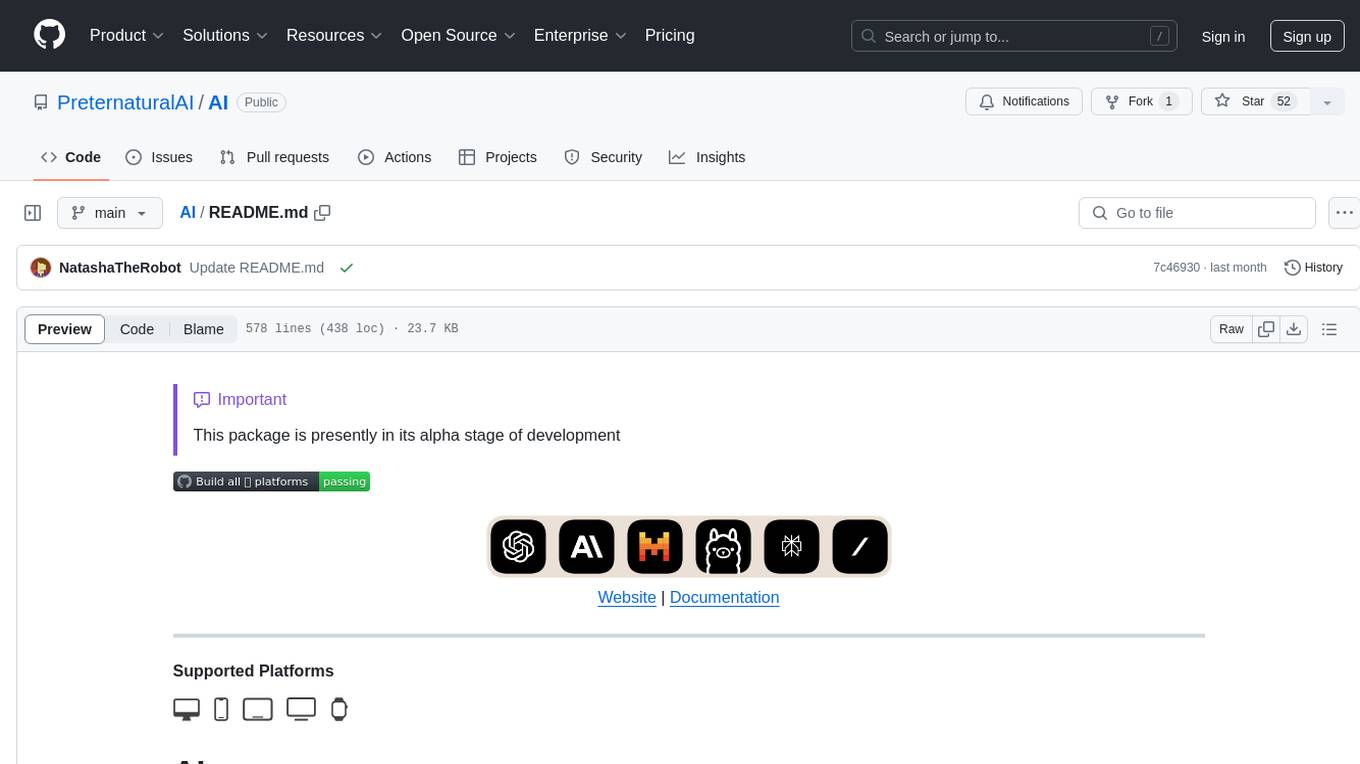
AI
AI is an open-source Swift framework for interfacing with generative AI. It provides functionalities for text completions, image-to-text vision, function calling, DALLE-3 image generation, audio transcription and generation, and text embeddings. The framework supports multiple AI models from providers like OpenAI, Anthropic, Mistral, Groq, and ElevenLabs. Users can easily integrate AI capabilities into their Swift projects using AI framework.
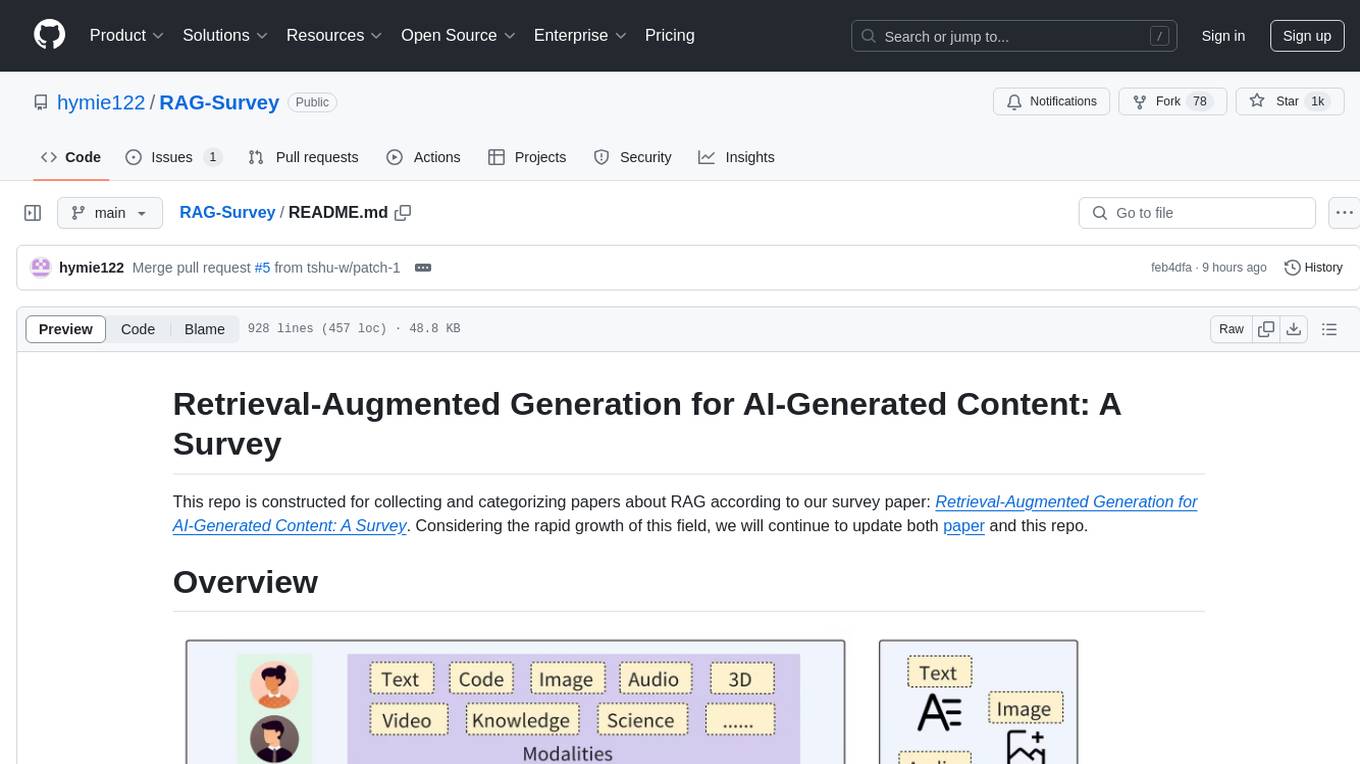
RAG-Survey
This repository is dedicated to collecting and categorizing papers related to Retrieval-Augmented Generation (RAG) for AI-generated content. It serves as a survey repository based on the paper 'Retrieval-Augmented Generation for AI-Generated Content: A Survey'. The repository is continuously updated to keep up with the rapid growth in the field of RAG.
For similar jobs

RAVE
RAVE is a variational autoencoder for fast and high-quality neural audio synthesis. It can be used to generate new audio samples from a given dataset, or to modify the style of existing audio samples. RAVE is easy to use and can be trained on a variety of audio datasets. It is also computationally efficient, making it suitable for real-time applications.
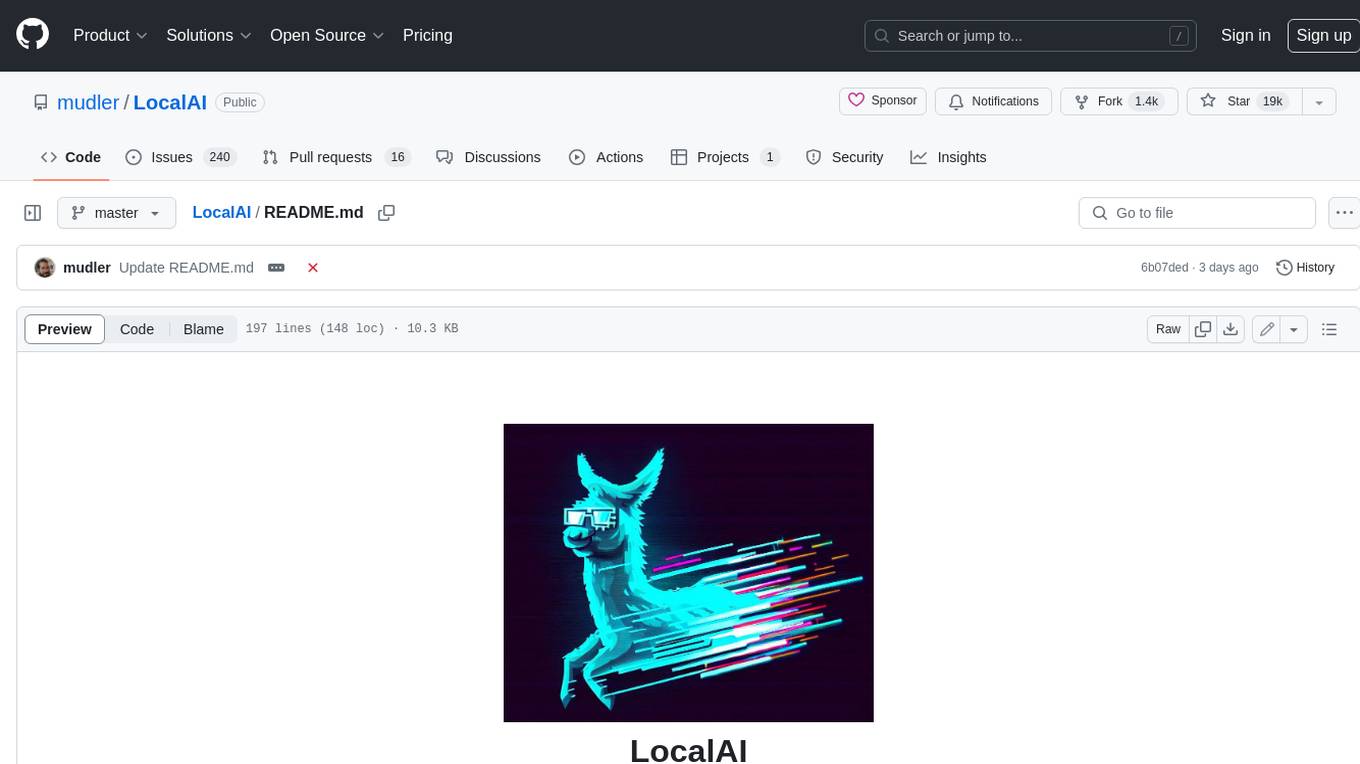
LocalAI
LocalAI is a free and open-source OpenAI alternative that acts as a drop-in replacement REST API compatible with OpenAI (Elevenlabs, Anthropic, etc.) API specifications for local AI inferencing. It allows users to run LLMs, generate images, audio, and more locally or on-premises with consumer-grade hardware, supporting multiple model families and not requiring a GPU. LocalAI offers features such as text generation with GPTs, text-to-audio, audio-to-text transcription, image generation with stable diffusion, OpenAI functions, embeddings generation for vector databases, constrained grammars, downloading models directly from Huggingface, and a Vision API. It provides a detailed step-by-step introduction in its Getting Started guide and supports community integrations such as custom containers, WebUIs, model galleries, and various bots for Discord, Slack, and Telegram. LocalAI also offers resources like an LLM fine-tuning guide, instructions for local building and Kubernetes installation, projects integrating LocalAI, and a how-tos section curated by the community. It encourages users to cite the repository when utilizing it in downstream projects and acknowledges the contributions of various software from the community.







